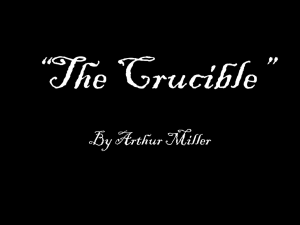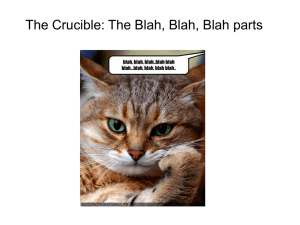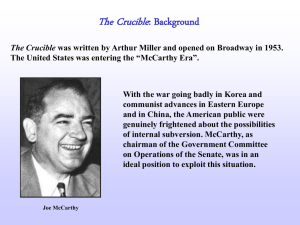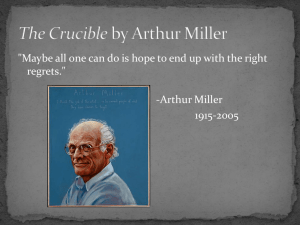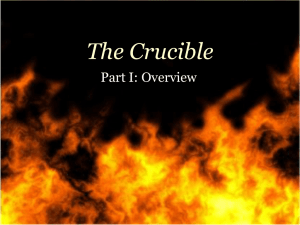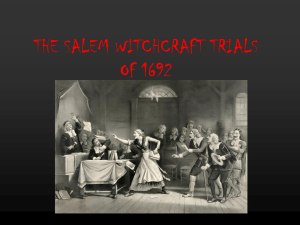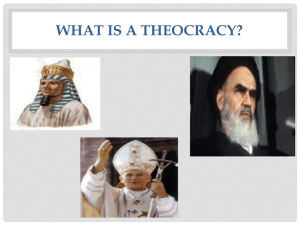The crucible good pp
advertisement
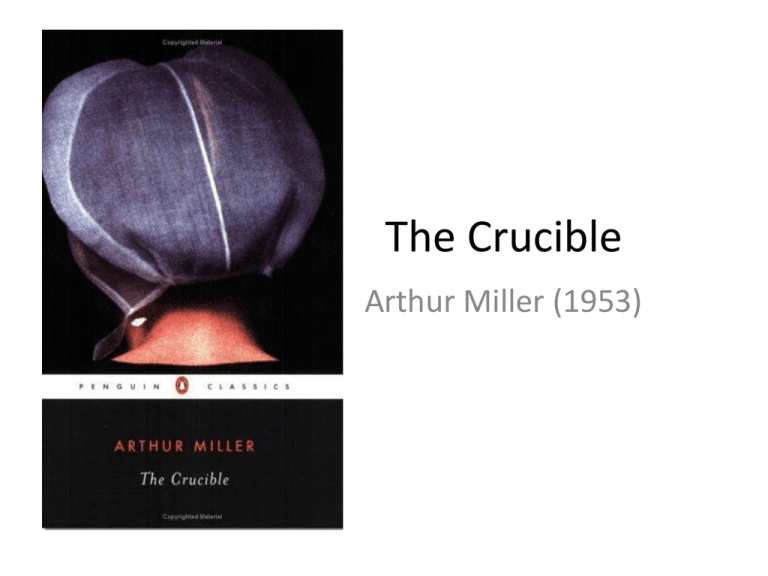
The Crucible Arthur Miller (1953) 1915 - 2005 Arthur Miller’s 2nd wife, Marilyn Monroe • He was born in 1915 and died 2005. • He was born in New York. • His grandparents came to America from Poland. His parents, Gussie and Isodore Miller ran a successful coat making company – Millitex Suit and Coat Co. until the 1929 Wall Street crash. Before the crash, he and his family lived a comfortable life. After the business failed they moved to Brooklyn and he worked in a warehouse to earn money to pay for his university fees. • He worked for a while as a journalist. Between the years of journalism and becoming a successful playwright, he worked on the Brooklyn shipyards for 2 years. • He was married 3 times, most famously to Marilyn Monroe but it quickly ended in divorce. Miller was always interested in the tragedy of people who, under social pressure, lose their integrity. The Crucible explores this theme in the context of the Salem witch trials. Many citizens of Salem lost their sense of decency and community when they went along with the crowd to continue persecution of the innocent. • His plays were at times politically motivated. • America was caught in the grip of the cold war. He said, ‘people were saying things that were absurd and based whole political platforms on them.’ He felt that the political system and freedoms were under jeopardy and threat. • His writing is concerned with political and moral issues. He expressed an interest in how personal relationships dictate the way one leads one’s life and about people’s struggles to do what is right. Miller wrote this play in the late 1940s when Senator Joseph McCarthy chaired a committee to rid the United States government, and the nation, of Communists. During the McCarthy Era many of Arthur Miller's friends were attacked for their so-called pro-communist beliefs. Miller himself was called before the House [of Representatives] Un-American Activities Committee (HUAC) in 1956 to testify against his friends and, like John Proctor in the play, refused to implicate them. In 1952, Miller’s good friend, Elia Kazan appeared before the House Un-American Committee and, under fear of being blacklisted from Hollywood, named eight people from the Group Theatre who in recent years had been fellow members of the Communist Party. After speaking with Kazan about his testimony Miller traveled to Salem, Massachusetts to research the witch trials of 1692. ‘It would probably never have occurred to me to write a play about the Salem witch trials of 1692 had I not seen some astonishing correspondences with that calamity in the America of the late 40s and early 50s. My basic need was to respond to a phenomenon which, with only small exaggeration, one could say paralysed a whole generation and in a short time dried up the habits of trust and toleration in public discourse.’ Arthur Miller • Miller was deeply concerned with the effect the ‘spy hysteria’ was having on the lives of people. • He intended to warn contemporary America of the danger of unfounded mass hysteria. • He wanted to show how fear, suspicion and insecurity can overcome reason. • He wanted to show that we should aim to maintain our integrity, independence, honesty and loyalty. • He wanted to show how humans react in such a crucible or test. • Miller attempts to demonstrate the existence of opposites in any society and how this polarisation of beliefs can lead to conflict • These ideas are not just tied to Salem and America in the 1950’s. How are these ideas relevant to us today? • In WW2, the United States and the Soviet Union were allies. • After the war was over, the two countries became more and more suspicious of each other. • They had two different ideologies. United States Soviet Union Democracy Communist Parliamentary democracy Dictatorship Became enemies – did not engage in open warfare but did side with different countries engaged in conflict. This period was know as the Cold War. • America began to worry that the communists might try to take over the United States. • Senator McCarthy was made chairman of the House Un-American Activities committee. • This committee’s job was to find communists and communist sympathisers living and working the United States. • They were particularly interested in people in the media as they had influence. • Arthur Miller was called to testify in front of the House Un-American Activities Committee to name names of communist sympathizers in 1956 • Miller refused to do so and was heralded by the arts community for his strength of conviction and loyalty. • Some who did not provide information were jailed, many lost their jobs because they were blacklisted. • Miller chose to be loyal to his fellow artists, but Miller went against the cultural consensus at the time • Some like his friend Elia Kazan informed on people in order to keep their jobs. There was great pressure from the government and FBI and CIA. Kazan’s betrayal was of great concern to Miller. Miller’s passport was withheld but he remained steadfast and did not compromise his beliefs. • In 1957, Miller was charged with contempt, a ruling later reversed by the U.S. Court of Appeals. He was fined $500. • Miller used his plays to strongly condemn the McCarthy trials and those who named the names of innocent artists. • Republican Senator from Appleton, Wisconsin • WWII veteran who liked to call himself ‘Tailgunner Joe’ • Made little impact in the Senate until February 9, 1950 when he gave a speech at the Republican Women's Club of Wheeling, West Virginia, where he claimed to have a list of 205 Communists in the State Department. No one in the press actually saw the names on the list, but McCarthy's announcement made the national news. In December 1954, the Senate voted to censure him for his conduct and to strip him of his privileges. McCarthy died three years later, but the term "McCarthyism" lives on to describe anti-Communist fervor, reckless accusations, and guilt by association. • Exaggerated fear of common evil (communism) • Refusing to answer was a sign of guilt • Innocent people named and persecuted • Mass over-reaction to a situation due to fear and suspicion • Distortion of truth to provide a common scapegoat • Insecure times – fear of alternative ideas • McCarthy's attacks emerged within a climate of political and social conformity. • One state required pro wrestlers to take a loyalty oath before stepping into the ring. • In Indiana, Robin Hood (and its vaguely socialistic message) librarians were forced to pull the book from the shelves. • Baseball's Cincinnati Reds renamed themselves the "Redlegs." • Cosmetics companies recalled a face powder called "Russian Sable" and renamed it "Dark Dark." • Starting in Dearborn, Michigan, and spreading to other parts of the country, "Miss Loyalty" beauty contests became the rage. • Events in The Crucible have strong parallels with the House of Un-American Activities Committee, led by Joseph McCarthy who conducted witch-hunts (campaign to find or investigate people considered to be unorthodox or disloyal) to expose communists or communist sympathisers. • Tale of persecution – religious (Salem) - ideological (USA) • Used theatre to explore the conflict and present his point of view about freedom of the individual within an autocratic society. ‘The witch hunt was a perverse manifestation of the panic which set in among all classes when the balance began to turn toward greater individual freedom.’ Arthur Miller – introductory notes Just as John Proctor comes to see that reason fails to protect him and his wife, so too did Miller • Based on real events that took place in Salem, Massachusetts in 1692. • A group of teenage girls seemed to be suffering from a strange illness • Illness blamed on witchcraft • There was an official investigation • By April over 300 suspected witches were imprisoned. • June – death penalty was introduced and Brigid Bishop was the 1st hanged. • Then – 5 more women including the real Rebecca Nurse and Sarah Good in July. "Examination of a Witch" in Salem • John Proctor – concerned at the way torture was used to make people confess wrote to the minister of Boston and called for an investigation • His claims were ignored • Hanged with 4 others • His wife, Elizabeth was pregnant and escaped punishment • 8 more hanged before trial ends in Sept. In total, 20 people were hanged • Later Government acknowledge convictions and executions had been a mistake. • Proctor was an inn keeper • Abigail was 11 • Escaped Europe as they suffered persecution for their extreme views. • 1st settlement was almost wiped out – only about 100 survived • Strictly obeyed the bible • Strict and serious lifestyle • Sensible dark clothing, covered all but hands and face. • Forbade ‘vain enjoyment’ – reading, theatre, dancing, singing (p14) • The puritans were one of the first European settlers to live in this part of North America • They were fighting a physical battle with environment – wilderness, climate, natives • P14 ‘edge of wilderness was close by’ and ‘it stood, dark and threatening.’ • They were under constant threat of losing everything. • Tense and paranoid • p13 – Settlement 1652 (40 years earlier) ‘To the European world the whole province was a barbaric frontier inhabited by a sect of fanatics’ • Indian tribes ‘marauded from time to time’ and they ‘lost relatives to these heathens’ (p14) • They took land from the Indians – were not able to convert them to Christianity. (15) • Believed the forest was the Devil’s ‘last preserve, his home base and the citadel of his final stand.’ (p15) • Persecuted in Europe and in Massachusetts they tried to kill off the Puritans so they had to unite. • Autocracy by consent – from top to bottom of society Salem • Salem was a theocracy – community believed that God was the highest power and that religious laws and the laws of the state were one. “…this is the court of law. The law, based on the Bible, and the Bible, writ by Almighty God.”(p92) • Representatives of God were considered god-like and could not be crossed or questioned (bringing them into conflict with the honest citizens of Salem) • The colony was founded and relied on religion. • Any threat to religion was taken as a threat to the people. • P16 – ‘for good purposes, even high purposes, the people of Salem developed a theocracy, a combine of state and religious power whose function was to keep the community together, and to prevent any kind of disunity that might open it to destruction by material or ideological enemies. It was forged for a necessary purpose and accomplished that purpose.’ • So what went wrong? ‘the witch-hunt was a perverse manifestation of the panic which set in among all classes, when the balance began to turn toward greater individual freedom.’ The society had not yet achieved a balance. • The witch hunts were an opportunity to publicly express guilt and sin, express and take vengeance, settle old scores. Why do you think Miller explains the background so carefully and in detail at the beginning of Act 1? Salem in the 1760's (School Street) The Salem Witch House (1642), home of Jonathan Corwin Rev Samuel Parris In 1689 the villagers won the right to establish their own church and chose the Reverend Samuel Parris, a former merchant, as their minister. His rigid ways and seemingly boundless demands for compensation— including personal title to the village parsonage—increased the friction. Many villagers vowed to drive Parris out, and they stopped contributing to his salary in October 1691. • Mid forties • ‘in history he cut a villainous path, and there was very little good to be said for him. • He believed he was being persecuted wherever he went, despite his efforts to win people and God to his side. • In meetings, he felt insulted if someone rose to shut the door or window without first asking his permission. • Widower • Proctor says to Parris, ‘There are many others who stay away from church these days because you hardly ever mention God anymore.’ (p34) • Most people believed in witches and witchcraft, not just poorly educated and superstitious. • In the 16th and 17th centuries, over 60,000 people were executed for witchcraft in Europe and United states. Most were poor, old women. • Signs of witchcraft – power to fly, reading books, muttering curses, making potions with live animals, sending out spirits. • Fear based on ignorance – anything they could not explain was caused by Satan and a witch (a young female) carried out his evil plans. The June 10, 1692 hanging of Bridget Bishop "The Trial of George Jacobs, August 5, 1692." By T. H. Matteson, 1855. Oil painting. Original document convening the witch trials Magistrate Samuel Sewall (1652-1730) • Conflict with their environment – ‘barbaric frontier’, harsh land, the heathen Indians and the Devil, who they see lurking everywhere. • Conflict with each other - Interpersonal conflict – ‘long-held hatred’, ‘land lust’, revenge, ‘suspicion’ and ‘envy’. • Conflict with religious leaders / individual versus authority • Appearance versus reality • Intrapersonal conflict A crucible is a melting pot designed to withstand great heat that contains diverse, perhaps incompatible, elements. These elements may ferment to create an adverse reaction. Characters: Good – have positive, unselfish and hones motives (truth, reconciliation) Evil – have negative, selfish and dishonest motives (lust, revenge) Good Proctor – admits to his mistakes, refuses to lie, even though it would save his life, Evil • Theocracy (combination of state and religious power) • Superstitious nature of people reinforced by theocracy • Theocracy felt threatened by good, independent individuals • Religion misused to promote witchcraft • Evil part of human condiction • Battle between individual freedom and uniformity of an ordered society (theocracy) • John Proctor versus the Salem court (private and public conflict) • Tragedy and triumphs of individuals over society. • Witch hunts force the citizens of Salem to make a terrible choice between compliance to an uncompromising authority and their own consciences. • Courts – inflexible in their pursuit of evil • Religious zeal gives the authorities moral as well as legal conviction – Deputy Governor Danforth – ‘while I speak God’s law, I will not crack its voice with whimpering.’ (p113) • He argues that good Christians can only be with the court or against it (p88) • Difference between characters’ public persona and their private reality • Society’s public ‘justice’ and private shame and guilt • John Proctor’s personal values of reason and factual truth come into conflict with Salem’s dominant values of community harmony and conformity. • Inner turmoil as a result of his lust for Abigail and affair with Abigail. • Conflict with wife, for betraying their marriage • Religious conflict against the Church’s teachings. • THEATRE/ LITERATURE: a serious play with a tragic theme, often involving a heroic struggle and the downfall of the main character • John Proctor is a good man, flawed and brought down by his moment of weakness. He suffers inner turmoil as a result of his lust and guilt for his affair with the servant, Abigail. • Proctor’s conscience prevents him from lying, from tarnishing his good name and ultimately leads to his death. • That it is better to forfeit one’s life for principles than to avoid conflict by agreeing to what is a lie. • Questions how representatives of religious authority can condone large scale injustices. ‘For good purposes, even high purposes, the people of Salem developed a theocracy, a combination of state and religious power whose function was to keep the community together and to prevent any kind of disunity that might open it up to destruction by material or ideological enemies. But all organisation is and must be grounded on the idea of exclusion and prohibition, just as two objects cannot occupy the same space. The repressions of the order were heavier than seemed warranted by the dangers against which the order was organised.’ Miller – Introductory notes • Representative of the ‘highest court of the supreme government’ • Angry and blindly resolute in his mission to uphold God’s law and creates more conflict. • Victim of his own dogmatism and power • Believes the reasoning, “confess yourself or you will hang” will elicit the truth. • Displays some conscience and courage • Changes from believer to guilt ridden sceptic, saying, “there is blood on my head.” (p114) • Ultimately powerless


